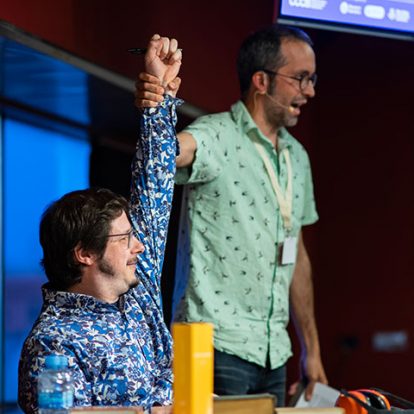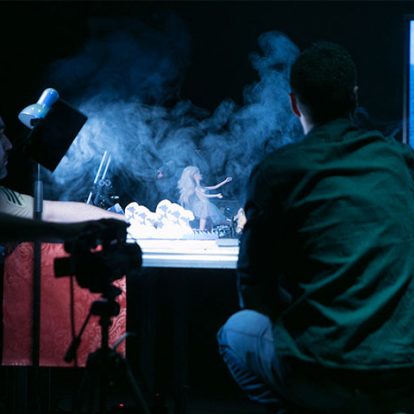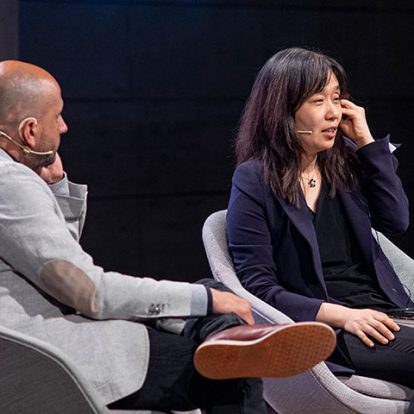Literary Dialogues at Kosmopolis
Eva Rexach
29 September 2017
Jean Echenoz and Jean-Yves Jouannais. John Banville and Pierre Lemaitre. Werner Herzog and Paul Holdengräber. The K Dialogues for the 2017 edition of Kosmopolis played host to authors with similar track records which enabled us to zoom in closer on their work, discover some of their secrets and enjoy a few anecdotes from beyond the literary sphere.
The K Dialogues always offer some of the high points in the Kosmopolis programme. They are an opportunity to discover first-hand the affinities between two authors, their points of convergence and where their admiration lies. At this edition we had the opportunity to meet close-up with authors who were all first-time participants at Kosmopolis (Jean Echenoz and Jean-Yves Jouannais, John Banville and Pierre Lemaitre and Werner Herzog and Paul Holdengräber) and to travel with them around the remains of Europe, the crime novel and cinema.
The appearances and disappearances of Jean Echenoz and Jean-Yves Jouannais
French authors Jean Echenoz and Jean-Yves Jouannais kicked off the dialogues with a conversation about appearances and disappearances in literature. About the disappearance of the second surname (Jean Echenoz also has a double-barrel surname), about the disappearance of Europe or of certain characters: Echenoz recovered the figures of Tesla, Ravel and Zatopek with the intention of making them appear once more (“Every book is the realisation of something. But, at the same time, it does not completely satisfy absolutely everything that I want to say”) and Jouannais writes about the remains of the continent. “It is ridiculous to think this,” said Jean-Yves Jouannais, “but perhaps the cities are tired of us and of how we are destroying them”.
The crime novel according to John Banville and Pierre Lemaitre
John Banville and Pierre Lemaitre established a dialogue on genre literature, which the two of them believe is not highly considered. “Nobody casts doubt on the fact that Simenon is a great author”, said Lemaitre, “but the crime novel continues to be regarded as a sub-genre.” Banville added: “I don’t like the idea of genre. I think there are just good books and books that aren’t so good”.
Both Banville and Lemaitre coincided in affirming that the crime novel is a genre that has survived because the themes it talks about are part of the human soul: Pierre Lemaitre affirmed that “Precarity, unemployment, poverty… They are symbolic violence. The crime novel functions like an anti-anxiety pill,” and John Banville noted that in crime fiction, “ordinary people do extraordinary things. It shows us about ourselves that we are capable of anything” and that even the Greek tragedies are crime novels.
The two authors also talked about their work methods: Banville writes with a fountain pen; Benjamin Black, his crime author alter ego, with a computer; Lemaitre confessed that he wrote up to 22 versions of the first chapter of his last novel, Ressources inhumaines, because for him, “writing means re-writing”.
Iguanas and the ecstasy of God: Werner Herzog and Paul Holdengräber
The last K Dialogue was an event the likes of which has rarely been seen at Kosmopolis. Expectation were extremely high for seeing Warner Herzog in dialogue with Paul Holdengräber, director of the New York Public Library and a great friend of his. The meeting swung between the surrealism of some scenes from Herzog’s films (“iguanas belong to the ecstasy of the creation,” said the filmmaker speaking about the famous iguana scene of Bad Lieutenant) to anecdotes from the films or the impact of nature on his work. “Nature itself is not completely friendly”, he said in reference to the títol de la xerrada Ecstasy and Terror in the Mind of God, i va afegir que està tired of the images of a nature that is all panda bears. The fascination that this dialogue sparked among the K17 audience explains why tickets for it sold out just a few minutes after going on sale.









